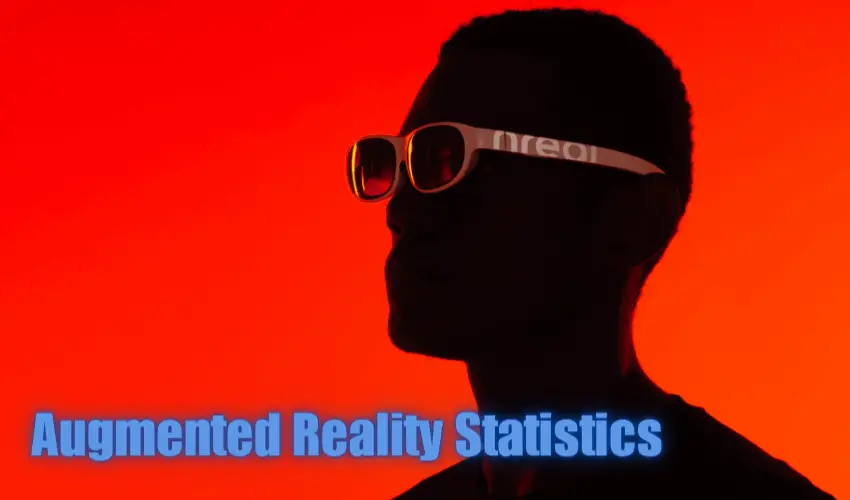
The military first adopted augmented reality (AR).
Over the years, augmented reality will be a part of of your life somehow.
This article explores how augmented reality impacts our lives and why potential investors should read it.
Key Highlights Of the Augmented Reality market
- The number of mobile augmented reality (AR) users is likely to rise from 200 million in 2015 to 1.7 billion by 2024, an increase of 1.5 billion.
- 70% of Americans believe that augmented reality will be a part of their everyday lives.
- 82% of Americans anticipate using AR and VR more frequently.
- In 2023, the AR & VR industry is anticipated to generate US$31.12 billion in revenue.
- Market volume is anticipated to reach US$52.05 billion by 2027, with revenue predicted to expand at a 13.72% CAGR from 2023 to 2027
- From 2018 to 2023, searches on Google for AR Glasses have increased by 172.2 percent.
Mobile augmented reality (AR) active user devices worldwide from 2019 to 2024 (in billions)
From 2019 through 2024, the growth is anticipated to be a staggering 293.18%.
Globally, it is predicted that 1.1 billion mobile AR user devices will be in use.
Information source Statista
Market Penetration
In 2023, it is anticipated there will be 28.8% of users, and by 2027, 32.6% of users are anticipated, a 13.10% increase in users.
In 2022, the user penetration rates for augmented reality (AR) and virtual reality (VR) were around 26.4%.
By the end of 2027, Statista predicts that this percentage will rise to 32.6%.
The average revenue per user is anticipated to be $12.55.
While the market predictions are strong it is worth pointing out that the statistics from Statista only cover B2C, which does not reflect on the lucrative B2B market sector, where growth is also expected to be impressive as the industry embraces the technology further.
Predicted AR Headset Shipments Worldwide
The increase in headsets being shipped worldwide amounts to a 9871% increase in 8 years.
Anticipated Distribution of AR Headsets Worldwide
- The percentage of Standalone HMD shipments, which are expected to total 24 million devices, is 58.39%.
- Tethered HMD shipments, with a projected total of just over $17 million, made up 41.55% of all shipments.
- 0.06% is the estimated percentage of viewers without screens, even though just 30,000 devices have been distributed.
- At 53%, the consumer segment accounts for the majority of spending.
- Public Sector (12.7%)
- Manufacturing and Resources (13.8%)
- Distribution and Services (15.8%)
- Infrastructure (3.2%)
- The remaining sectors provide just 1.6% of the total spending.
Information source Finance online IDC
AR Glasses Searches
Searches for AR Glasses over the past 5 years from 2018 to 2023 has increase by 172.2.%.
With the most popular areas being Arkansas, Washington, Utah, Oklahoma, and California.
AR Glasses Brands
Nreal air glasses surged 900% over a 12-month period on Google, followed by Nreal air with a 1300% increase.
Halogen 2 and Nreal standard glasses remain stable with fewer searches but maintain their popularity as leading AR glasses.
VR headsets are popular, suggesting a potential reason why searches have decreased.
Searches by region
- Washington
- Virginia
- Maryland
- Ohio
- Tennessee
Information source Google Trends VR Compare
How Are Consumers Using Augmented Reality?
34% of buyers are already using augmented reality when shopping.
In-store and online shopping account for 47% of its use.
The most preferred augmented reality applications examine product changes, such as potential variations in colors and styles.
65% of AR users frequently use it to learn about a product.
Influence of AR
According to 71% of shoppers, using AR apps would encourage them to shop more frequently.
According to 61% of shoppers favored shopping at stores offering augmented reality.
55% acknowledged that AR makes buying more thrilling and fun.
40% of consumers believe they would be willing to pay more for a product if they could test it using augmented reality.
Impulse buying is encouraged by augmented reality
72% of AR users reported doing so due to the technology.
Customers are more engaged and spend more time in stores when AR is available. While 45% of shoppers claimed that AR saves them time, 68% stated that they would like to spend more time there.
AR retail market
Information source Think Mobiles
Augmented Reality & HealthCare
The global market for augmented reality (AR) in healthcare is estimated to be about $610 million in 2018. By 2026, it is anticipated to exceed $4.2 billion, an increase of 593%.
By 2032, the market for augmented and virtual reality in healthcare will be worth USD 18.5 billion.
The North American area accounted for about 40.5% of healthcare’s augmented and virtual reality market.
The use of AR/VR in healthcare will grow due to rising investments in related tools and products, technological advancements, and other supportive government activities.
Information source Statista Global News
Conclusion
In the domestic setting, retail, and healthcare, augmented reality will grow exponentially.
70% of Americans believe that augmented reality will soon become a part of their everyday lives.
In the future, 82% of Americans anticipate using AR and VR more frequently.
It is estimated that AR & VR will generate US$31.12 billion in revenue in 2023.
This is the tip of the iceberg.

